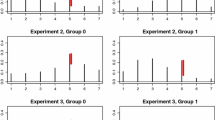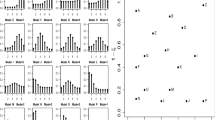Abstract
In rating surveys, people are requested to evaluate objects, items, services, and so on, by choosing among a list of ordered categories. In some circumstances, it may happen that a subset of respondents selects a specific option just to simplify a more demanding choice. In this context, we generalize a class of ordinal data models (called cub and proven effective for fitting and interpretation), for taking the possible presence of a shelter choice into account. After the discussion of interpretative and inferential issues, the usefulness of the approach is checked against real case studies and by means of a simulation experiment. Some final remarks end the paper.
Similar content being viewed by others
References
Agresti A (2002) Categorical data analysis, 2nd edn. Wiley, New York
Agresti A (2010) Analysis of ordinal categorical data. Wiley, Hoboken
Balirano G, Corduas M (2008) Detecting semiotically expressed humor in diasporic TV productions. HUMOR Int J Humor Res 3: 227–251
Bock RD, Moustaki I (2007) Item response theory in a general framework. In: Rao CR, Sinharay S (eds) Psychometrics, handbook of statistics, vol 26. Elsevier, Amsterdam, pp 469–513
Caliendo G, Iannario M (2009) Communicating European values in institutional discourse: a statistical model for the analysis of citizens’ perception of the EU. GlottoTheory Int J Theor Linguist 2: 19–40
Camarda CG, Eilers PHC, Gampe J (2008) Modelling general patterns of digit preference. Stat Model 8: 385–401
Cerchiello P, Iannario M, Piccolo D (2010) Assessing risk perception by means of ordinal models. In: Corazza M, Pizzi C (eds) Mathematical and statistical methods for actuarial sciences and finance. Springer, Heidelberg, pp 65–73
Chen Z (2001) Data mining and uncertain reasoning, an integrated approach. Wiley, New York
Chin HC, Quddus MA (2003) Modelling count data with excess zeros. An empirical application to traffic accidents. Sociol Methods Res 32: 90–116
Corduas M (2008) Clustering CUB models by Kullback-Liebler divergence. In: Proceedings of SCF-CLAFAG meeting. ESI, Napoli, pp 245–248
Corduas M et al (2011) Assessing similarity of rating distributions by Kullback-Liebler divergence. In: Fichet B (eds) Classification and multivariate analysis for complex data structures. Studies in classification, data analysis, and knowledge organization. Springer, Heidelberg, pp 221–229
Corduas M, Iannario M, Piccolo D et al (2009) A class of statistical models for evaluating services and performances. In: Bini M (eds) Statistical methods for the evaluation of educational services and quality of products. Contribution to statistics. Springer, Heidelberg, pp 99–117
Davison AC, Hinkley DV (1997) Bootstrap methods and their application. Cambridge University Press, London
D’Elia A (2008) A statistical modelling approach for the analysis of TMD chronic pain data. Stat Methods Med Res 17: 389–403
D’Elia A, Piccolo D (2005) A mixture model for preference data analysis. Comput Stat Data Anal 49: 917–934
Dempster AP, Laird NM, Rubin DB (1977) Maximum likelihood from incomplete data via the EM algorithm. J R Stat Soc Ser B 39: 1–38
Dittrich R, Hatzinger R, Katzenbeisser W (2004) A log-linear approach for modelling ordinal paired comparison data on motives to start a PhD programme. Stat Model 4: 181–193
Dittrich R, Francis B, Hatzinger R, Katzenbeisser W (2007) A paired comparison approach for the analysis of sets of Likert-scale responses. Stat Model 7: 3–28
Everitt BS, Hand DJ (1981) Finite mixture distributions. Chapman & Hall, London
Farewell VT, Sprott DA (1982) The use of a mixture model for the analysis of survival data with long-term survivors. Biometrics 38: 1041–1046
Farewell VT, Sprott DA (1998) The use of a mixture model in the analysis of count data. Biometrics 44: 1191–1194
Fielding A, Yang M, Goldstein H (2003) Multilevel ordinal models for examination grades. Stat Model 3: 127–153
Fligner MA, Verducci JS (1993) Probability models and statistical analyses of ranking data. Springer, New York
Grilli L, Rampichini C (2002) Specification issues in stratified variance component ordinal response models. Stat Model 2: 251–264
Hall DB (2000) Zero-inflated poisson and binomial regression, with random effects: a case study. Biometrics 56: 1030–1039
Hartzel J, Agresti A, Caffo B (2001) Multinomial logit random effects models. Stat Model 1: 81–102
Heilbron D (1994) Zero-altered and other regression models for count data with added zeros. Biometr J 36: 531–547
Iannario M (2007) A statistical approach for modelling urban audit perception survey. Quaderni di Statistica 9: 133–172
Iannario M (2008) A class of models for ordinal variables with covariates effects. Quaderni di Statistica 10: 53–72
Iannario M (2010) On the identifiability of a mixture model for ordinal data. Metron LXVIII: 87–94
Iannario M (2011a) Preliminary estimators for a mixture model for ordinal data (submitted)
Iannario M (2011b) Hierarchical cub models for ordinal variables. Communications in statistics. Theory and methods (accepted)
Iannario M, Piccolo D (2009) A program in \({\tt {R}}\) for cub models inference, version 2.0. http://www.dipstat.unina.it/CUBmodels1/
Iannario M, Piccolo D (2010a) A new statistical model for the analysis of customer satisfaction. Qual Technol Quant Manag 7: 149–168
Iannario M, Piccolo D (2010b) Statistical modelling of subjective survival probabilities. Genus LXVI: 17–42
Iannario M, Piccolo D (2011) cub models: statistical methods and empirical evidence. In: Kenett RS, Salini S (eds) Modern analysis of customer surveys, with applications using R. Wiley, New York, pp 231–254
Johnson NL, Kotz S, Kemp AW (1992) Univariate discrete distributions, 2nd edn. Wiley, New York
King G (1998) Unifying political methodology. The likelihood theory of statistical inference. The University of Michigan Press, Ann Arbor
Lambert D (1992) Zero-inflated Poisson regression, with an application to defects in manifacturing. Technometrics 34: 1–14
Lawless HT, Heynmann H (1999) Sensory evaluation of food. Principles and practice. Springer, New York
Leti G (1979) Distanze e indici statistici. La Goliardica editrice, Roma
Manski CF, Molinari F (2010) Rounding probabilistic expectations in surveys. J Bus Econ Stat 28: 219–231
Marden JI (1995) Analyzing and modelling rank data. Chapman & Hall, London
McCullagh P, Nelder JA (1989) Generalized linear models, 2nd edn. Chapman & Hall, London
McLachlan G, Krishnan T (1997) The EM algorithm and extensions. Wiley, New York
McLachlan G, Peel GJ (2000) Finite mixture models. Wiley, New York
Molenberghs G, Verbeke G (2007) Likelihood ratio, score, and Wald tests in a constrained parameter space. Am Stat 61: 22–27
Moustaki I, Steele F (2005) Latent variable models for mixed categorical and survival responses, with an application to fertility preferences and family planning in Bangladesh. Stat Model 5: 327–342
Mullahy J (1986) Specification and testing of some modified count data models. J Econ 33: 341–365
Paul RP, Banerjee T, Balasoorya U (2010) The multi-clump finite mixture distribution and model selection. Environmetrics 21: 133–142
Piccolo D (2003) On the moments of a mixture of uniform and shifted binomial random variables. Quaderni di Statistica 5: 85–104
Piccolo D (2006) Observed information matrix in MUB models. Quaderni di Statistica 8: 33–78
Piccolo D (2008) Modelling university students’ final grades by ordinal variables. Quaderni di Statistica 10: 205–226
Piccolo D, D’Elia A (2008) A new approach for modelling consumers’ preferences. Food Qual Prefer 19: 247–259
Piccolo D, Iannario M (2010) A class of models for interpreting consumer preferences by sensorial data. In: Proceedings of 11th European symposium of statistical methods for the food industry. University of Sannio, Benevento, pp 139–148
Rao CR (1973) Linear statistical inference and its applications, 2nd edn. Wiley, New York
Ridout M, Demétrio CGB, Hinde J (1998) Models for count data with many zeros. International biometric conference, IBC98, Cape Town, pp 1–13
Self SG, Liang KY (2003) Asymptotic properties of maximum likelihood estimators and likelihood ratio test under nonstandard conditions. J Am Stat Assoc 82: 605–610
Simonoff JS (2003) Analyzing categorical data. Springer, New York
Skrondal A, Rabe-Hesketh S (2003) Multilevel logistic regression for polytomous data and rankings. Psychometrika 68: 267–287
Train KE (2003) Discrete choice methods with simulation. Cambridge University Press, Cambridge
van den Broek J (1995) A score test for zero inflation in a Poisson distribution. Biometrics 51: 738–743
Vu HTV, Zhou S (1997) Generalization of likelihood ratio tests under nonstandard conditions. Ann Stat 25: 897–916
Author information
Authors and Affiliations
Corresponding author
Rights and permissions
About this article
Cite this article
Iannario, M. Modelling shelter choices in a class of mixture models for ordinal responses. Stat Methods Appl 21, 1–22 (2012). https://doi.org/10.1007/s10260-011-0176-x
Accepted:
Published:
Issue Date:
DOI: https://doi.org/10.1007/s10260-011-0176-x




